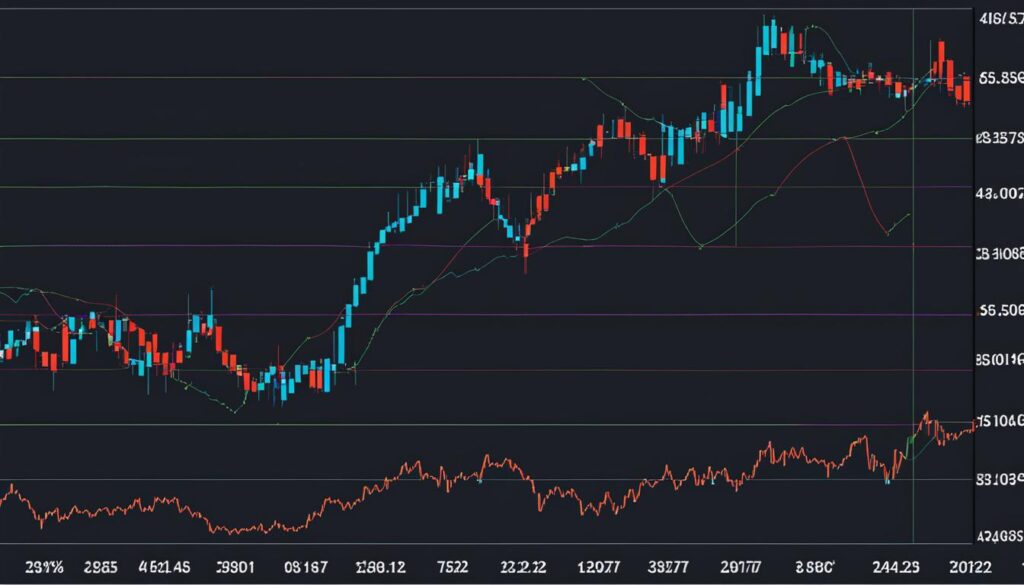In the world of advanced options trading, navigating volatile markets can be both challenging and potentially lucrative. As experienced traders know, having a diverse toolbox of effective trading strategies is essential for success. One such strategy that has gained popularity among seasoned traders is the Iron Albatross.
The Iron Albatross is a unique options trading strategy that capitalizes on minimal price movement in volatile markets. Combining elements of iron condors and iron butterflies, this four-legged strategy offers traders the opportunity to generate income while managing risk.
Key Takeaways:
- The Iron Albatross is an advanced options trading strategy designed for volatile markets.
- This strategy combines elements of iron condors and iron butterflies.
- Traders aim to profit from minimal price movement in the underlying asset.
- The risk profile is defined by the width of the wider spread and the net premium received.
- Traders must closely monitor the position and make adjustments if needed.
What is the Iron Albatross Strategy?
The Iron Albatross strategy is an advanced options trading strategy that combines elements of iron condors and iron butterflies. It involves selling an at-the-money call and put option while simultaneously buying an out-of-the-money call and put option that are further apart.
This options strategy is typically employed when traders anticipate minimal price movement in the underlying asset. By using credit spreads, the Iron Albatross strategy aims to generate income from the premiums received from selling options.
Here’s a breakdown of the Iron Albatross strategy:
- Sell an at-the-money call option
- Sell an at-the-money put option
- Buy an out-of-the-money call option at a higher strike price
- Buy an out-of-the-money put option at a lower strike price
By combining these options positions, traders can create a strategy with defined risk and profit potential. The Iron Albatross strategy allows traders to benefit from minimal price movement while leveraging credit spreads.
Benefits of the Iron Albatross Strategy
The Iron Albatross strategy offers several advantages:
- Income Generation: By selling options and receiving premiums, traders can generate income.
- Defined Risk: The risk profile of the strategy is limited and defined by the width of the spreads and the net premium received.
- Adaptable: Traders can make adjustments to the strategy or close portions of the position if market conditions change.
By understanding and implementing the Iron Albatross strategy, traders can potentially enhance their options trading strategies and navigate volatile markets effectively.
Example of the Iron Albatross Strategy
To illustrate the Iron Albatross strategy, let’s consider an example with a hypothetical stock, RST, currently trading at $200. The trade setup involves selling a $200 call option and a $200 put option, both fetching premiums of $7, while buying a $220 call option and a $180 put option for premiums of $2 each.
This is an example of the trading setup for the Iron Albatross strategy:
| Leg | Option | Premium |
|---|---|---|
| Sell | Call | $200 |
| Sell | Put | $200 |
| Buy | Call | $220 |
| Buy | Put | $180 |
The maximum profit is realized when the stock price is exactly at the strike of the sold options at expiration. However, losses can occur if the stock moves significantly from the initial price.
“The Iron Albatross strategy allows traders to generate income from selling options while limiting their risk exposure. It is a combination of credit spreads that aims to benefit from minimal price movement in the underlying asset.”
Traders must calculate the risk associated with the Iron Albatross strategy and manage the position accordingly. This includes monitoring the stock’s performance and being prepared to make adjustments or close portions of the position if needed.

The above table summarizes the trade setup for the Iron Albatross strategy. Traders can customize the strategy based on their risk profile and market outlook. By understanding the profit calculation and risk profile, traders can make informed decisions and enhance their options trading skills.
The Risk and Plan B for the Iron Albatross Strategy
The risk profile of the Iron Albatross strategy is defined by the width of the wider spread, offset by the net premium received. While the strategy can promise potential profits, a significant move in the stock price can lead to equal-sized losses. Traders must closely monitor the stock’s performance and be prepared to make adjustments or close portions of their position if the stock deviates from the desired target. By being proactive, traders can potentially avert losses and manage the risk associated with this strategy.
Risk Management and Strategy Monitoring
Successful implementation of the Iron Albatross strategy requires diligent risk management and ongoing strategy monitoring. Traders should closely track the stock’s performance and regularly assess whether adjustments are necessary to align the position with changing market conditions.
Key risk management techniques for the Iron Albatross strategy include:
- Setting strict stop-loss orders to limit potential losses and protect capital.
- Regularly reviewing and analyzing market trends and news that may impact the stock’s volatility.
- Monitoring the implied volatility of the options involved in the strategy to anticipate potential changes in premium values.
Making Adjustments and Preparing a Plan B
When trading the Iron Albatross strategy, it is crucial to have a plan B in case the stock price deviates from the desired target. Traders should be willing to make adjustments to their position to manage risk and mitigate potential losses.
Some adjustment techniques for the Iron Albatross strategy include:
- Rolling the unprofitable short options to a new strike, allowing the opportunity for the trade to recover.
- Closing a portion of the position if the stock price moves significantly, cutting potential losses.
- Implementing additional hedges, such as buying protective options, to offset potential losses in the strategy.
Example of Risk Management and Adjustment
Let’s consider an example using the Iron Albatross strategy with a stock trading at $200. The trader initiates the strategy by selling a $200 call and put option, each with a premium of $7. They simultaneously buy a $220 call and a $180 put option, each with a premium of $2.
After a few days, the stock’s price suddenly drops to $180. This movement puts the position at risk of incurring substantial losses. To manage the risk, the trader decides to close the short options and takes a loss on those positions. By closing the short options, the trader limits the potential losses and reduces the risk associated with the strategy.
To effectively execute the Iron Albatross strategy, traders must proactively monitor their positions, make necessary adjustments, and be prepared to adapt their plan when market conditions change. By implementing risk management techniques and having a plan B, traders can better navigate potential losses and maximize the potential for profitable outcomes.
Advanced Options Trading Strategies
When it comes to options trading, utilizing advanced strategies can provide traders with a competitive edge in navigating the intricacies of the market. Two popular options strategies that sophisticated traders employ are the iron butterfly and iron condor. These strategies are particularly effective in stagnant or slightly moving markets, where profit can be maximized through precise execution.
The Iron Butterfly Strategy
The iron butterfly strategy involves combining both call and put options to create a symmetrical profit-loss pattern. By simultaneously selling at-the-money call and put options and buying out-of-the-money call and put options, traders aim to generate income from the premiums received while limiting potential losses.
“The iron butterfly strategy is known for its defined risk and reward characteristics, making it an attractive choice for traders looking to capitalize on narrow price ranges.”
– Trading Expert
The Iron Condor Strategy
An iron condor strategy is similar to the iron butterfly but allows traders a wider profit range. It involves selling out-of-the-money call and put options while simultaneously buying further out-of-the-money call and put options. By doing so, traders can benefit from both a limited-risk and limited-reward scenario.
“The iron condor strategy’s risk-reward profile makes it popular among seasoned options traders, offering favorable profit potential in sideways markets.”
– Options Specialist
To better understand these advanced options trading strategies, let’s examine a comprehensive table comparing their key features:
| Options Strategy | Profit/Loss Profile | Profit Potential | Risk Level |
|---|---|---|---|
| Iron Butterfly | Maximum profit when the underlying asset closes at the strike price of the short options | Limited risk | |
| Iron Condor |  |
Potential profit when the underlying asset remains within the range of the short options | Limited risk |
It is crucial to thoroughly understand the mechanics, profit calculations, and risk profiles of these strategies before integrating them into your trading arsenal. Implementing a well-thought-out plan and regularly monitoring your positions can lead to enhanced trading performance and increased profitability.
Other Advanced Options Trading Strategies
Alongside the Iron Albatross strategy, there are numerous other advanced options trading strategies that traders can explore to enhance their trading portfolios. These strategies offer unique characteristics, profit potential, and risk profiles, allowing traders to tailor their approach based on individual trading goals, risk tolerance, and market outlook.
Butterfly Spread
Definition: A butterfly spread is a multi-leg options strategy that involves simultaneously buying and selling options with different strike prices but the same expiration date. This strategy aims to profit from minimal price movement in the underlying asset.
The butterfly spread consists of two components:
- Buying one in-the-money or at-the-money call or put option.
- Selling two at-the-money call or put options.
- Buying one out-of-the-money call or put option.
The risk and profit potential of a butterfly spread are limited, making it a popular choice in low-volatility markets.
Collar
Definition: A collar is an options strategy that combines a protective put and a covered call to minimize downside risk while potentially limiting upside potential. It involves holding a long stock position, buying a put option to protect against potential price declines, and simultaneously selling a call option to generate income.
The collar strategy is commonly employed by investors who own a stock with unrealized gains and want to protect those gains while still generating income. It provides a protective floor and a capped profit potential.
Synthetic Long Stock
Definition: A synthetic long stock is a strategy that simulates the ownership of long stock using options. It involves buying a call option and selling a put option with the same strike price and expiration date.
The synthetic long stock strategy allows traders to gain exposure to the upside potential of owning the underlying asset without needing to purchase the stock itself. It can be used when traders are bullish on the underlying asset’s price movement.
By familiarizing themselves with these additional advanced options trading strategies, traders can expand their toolkit and have more flexibility in navigating different market conditions. It is important to thoroughly understand the mechanics, profit potential, and risk profiles of each strategy before implementation.
Conclusion
Advanced options trading strategies, such as the Iron Albatross, offer traders a powerful toolset for navigating volatile markets. These strategies enable traders to capitalize on various market conditions and generate potential profits while effectively managing risk. However, it is crucial for traders to thoroughly understand the mechanics and associated risks of these strategies before implementing them in their trading activities.
By carefully monitoring the performance of their positions and making necessary adjustments, traders can elevate their skills and potentially achieve success in volatile markets. Implementing advanced options trading strategies requires a proactive approach, as market conditions can change rapidly. It is important to be adaptable and ready to make modifications to the trading strategy when necessary to optimize results.
With a solid understanding of advanced options trading strategies, including the Iron Albatross, traders gain the ability to navigate volatile markets with confidence. These strategies provide a comprehensive framework for managing risk, generating potential profits, and adapting to changing market conditions. By continuously improving their knowledge and honing their skills, traders can leverage advanced options trading strategies to achieve their financial goals in the ever-evolving world of trading.
FAQ
What is the Iron Albatross strategy?
The Iron Albatross is a four-legged options trading strategy that combines elements of iron condors and iron butterflies. It involves selling an at-the-money call and put option while buying an out-of-the-money call and put option further apart. This strategy is used when traders anticipate minimal price movement in the underlying asset. By using credit spreads, the strategy aims to generate income from the premiums received from selling options.
Can you provide an example of the Iron Albatross strategy?
Let’s consider an example with a hypothetical stock, RST, currently trading at $200. The trade setup involves selling a $200 call option and a $200 put option, both fetching premiums of $7, while buying a $220 call option and a $180 put option for premiums of $2 each.
What is the risk involved in the Iron Albatross strategy?
The risk profile of the Iron Albatross strategy is defined by the width of the wider spread, offset by the net premium received. While the strategy can promise potential profits, a significant move in the stock price can lead to equal-sized losses. Traders must closely monitor the stock’s performance and be prepared to make adjustments or close portions of their position if the stock deviates from the desired target.
Are there other advanced options trading strategies available?
Yes, in addition to the Iron Albatross strategy, there are numerous other advanced options trading strategies available to traders. These include the butterfly spread, collar, synthetic long stock, and many more. Each strategy has its own unique characteristics, profit potential, and risk profile. Traders should explore these strategies based on their individual trading goals, risk tolerance, and market outlook.
How can advanced options trading strategies benefit traders in volatile markets?
Advanced options trading strategies, such as the Iron Albatross, can be powerful tools for navigating volatile markets. These strategies allow traders to take advantage of various market conditions and generate potential profits while managing risk. However, it is important for traders to thoroughly understand the mechanics and risks associated with these strategies before implementing them in their trading.




Your article helped me a lot, is there any more related content? Thanks!